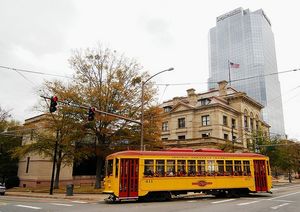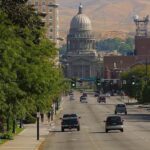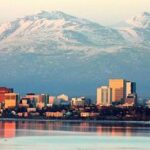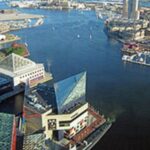This article, the fourth in a 50-state series, lists the twenty largest cities in Arkansas by population size and provides demographic details for each city: total population, population by age group, racial composition of the population, land area, and population density. For purposes of this article, cities are incorporated municipalities and census-designated places (CDPs).
After reading “Largest Cities in Arkansas (2011),” return to this link to read “Best Places to Live in Arkansas (2011) .”
Similar articles for the remaining 49 states can be found at these links: Alabama, Alaska, Arizona, California, Colorado, Connecticut, Delaware, Florida, Georgia, Hawaii, Idaho, Illinois, Indiana, Iowa, Kansas, Kentucky, Louisiana, Maine, Maryland, Massachusetts, Michigan, Minnesota, Missouri, Mississippi, Montana, Nebraska, Nevada, New Hampshire, New Jersey, New Mexico, New York, North Carolina, North Dakota, Ohio, Oklahoma, Oregon, Pennsylvania, Rhode Island, South Carolina, South Dakota, Tennessee, Texas, Utah, Vermont, Virginia, Washington, West Virginia, Wisconsin, and Wyoming .
1. Largest Cities in Arkansas (2011) : Little Rock, AR
Located in central Arkansas, Little Rock is the state’s capital and largest city with an estimated population of 193,524.
Grouped by age, 24.1% of the population is under 18, 9.6% is 18 to 24, 29.5% is 25 to 44, 25.4% is 45 to 64, and 11.4% is 65 or older. The median age of the population is 35.1.
The racial composition of the city is 48.9% White, 42.3% Black or African American, 0.4% Native American, 2.7% Asian, 0.1% Pacific Islander, 3.9% from other races, and 1.7% from two or more races. The population is 6.8% Hispanic or Latino of any race.
The land area of the city is 116.2 square miles. The city’s population density is 1,665 people per square mile.
2. Largest Cities in Arkansas (2011): Fort Smith, AR
Situated in the central part of western Arkansas, Fort Smith is the second largest city in the state with an estimated population of 86,209.
Classified by age, 25.5% of the population is under 18, 10.6% is 18 to 24, 26.2% is 25 to 44, 25.0% is 45 to 64, and 12.7% is 65 or older. The median age of the population is 35.1.
The racial complexion of the city is 69.3% White, 9.0% Black or African American, 1.8% Native American, 5.3% Asian, 0.1% Pacific Islander, 10.3% from other races, and 4.2% from two or more races. The population is 16.5% Hispanic or Latino of any race.
The land area of the city is 50.3 square miles. The city’s population density is 1,714 people per square mile.
3. Largest Cities in Arkansas (2011): Fayetteville, AR
Located in northwestern Arkansas, Fayetteville is the third largest city in the state with an estimated population of 73,580.
A comparatively large percentage of the population is college-aged: the city is home to the University of Arkansas. Categorized by age, 18.5% of the population is under 18, 26.1% is 18 to 24, 29.6% is 25 to 44, 17.9% is 45 to 64, and 7.9% is 65 or older. The median age of the population is 27.2.
The racial profile of the city is 83.8% White, 6.0% Black or African American, 1.1% Native American, 3.1% Asian, 0.2% Pacific Islander, 2.8% from other races, and 3.1% from two or more races. The population is 6.4% Hispanic or Latino of any race.
The land area of the city is 43.4 square miles. The city’s population density is 1,695 people per square mile.
4. Largest Cities in Arkansas (2011): Springdale, AR
Situated in northwestern Arkansas, Springdale is the fourth largest city in the state with an estimated population of 69,797.
Sorted by age, 32.6% of the population is under 18, 9.6% is 18 to 24, 30.0% is 25 to 44, 18.9% is 45 to 64, and 8.9% is 65 or older. The median age of the population is 29.6.
The racial makeup of the city is 64.7% White, 1.8% Black or African American, 1.0% Native American, 2.0% Asian, 5.7% Pacific Islander, 22.0% from other races, and 2.9% from two or more races. The population is 35.4% Hispanic or Latino of any race.
The land area of the city is 31.3 square miles. The city’s population density is 2,230 people per square mile.
5. Largest Cities in Arkansas (2011): Jonesboro, AR
Located in northeastern Arkansas, Jonesboro is the fifth largest city in the state with an estimated population of 67,263.
Arranged by age, 24.8% of the population is under 18, 14.8% is 18 to 24, 27.0% is 25 to 44, 21.5% is 45 to 64, and 11.9% is 65 or older. The median age of the population is 31.3.
The racial mix of the city is 74.7% White, 18.4% Black or African American, 0.4% Native American, 1.5% Asian, 3.0% from other races, and 2.0% from two or more races. The population is 5.2% Hispanic or Latino of any race.
The land area of the city is 79.6 square miles. The city’s population density is 845 people per square mile.
6. Largest Cities in Arkansas (2011) : North Little Rock, AR
Located in central Arkansas, North Little Rock is the sixth largest city in the state with an estimated population of 62,304.
Grouped by age, 24.1% of the population is under 18, 9.5% is 18 to 24, 27.7% is 25 to 44, 25.7% is 45 to 64, and 13.0% is 65 or older. The median age of the population is 35.9.
The racial composition of the city is 54.0% White, 39.7% Black or African American, 0.4% Native American, 0.9% Asian, 0.1% Pacific Islander, 2.7% from other races, and 2.1% from two or more races. The population is 5.7% Hispanic or Latino of any race.
The land area of the city is 44.8 square miles. The city’s population density is 1,391 people per square mile.
7. Largest Cities in Arkansas (2011): Conway, AR
Situated in central Arkansas, Conway is the seventh largest city in the state with an estimated population of 58,908.
A substantial percentage of the population is college-aged: the city is home to the University of Central Arkansas. Classified by age, 22.7% of the population is under 18, 22.9% is 18 to 24, 27.2% is 25 to 44, 18.5% is 45 to 64, and 8.7% is 65 or older. The median age of the population is 27.3.
The racial complexion of the city is 77.4% White, 15.6% Black or African American, 0.4% Native American, 1.9% Asian, 0.1% Pacific Islander, 2.4% from other races, and 2.2% from two or more races. The population is 5.1% Hispanic or Latino of any race.
The land area of the city is 35.1 square miles. The city’s population density is 1,681 people per square mile.
8. Largest Cities in Arkansas (2011): Rogers, AR
Located in northwestern Arkansas, Rogers is the eighth largest city in the state with an estimated population of 55,964.
Categorized by age, 30.6% of the population is under 18, 9.0% is 18 to 24, 29.9% is 25 to 44, 21.1% is 45 to 64, and 9.4% is 65 or older. The median age of the population is 31.7.
The racial profile of the city is 73.7% White, 1.4% Black or African American, 1.0% Native American, 2.6% Asian, 0.3% Pacific Islander, 18.1% from other races, and 3.0% from two or more races. The population is 31.5% Hispanic or Latino of any race.
The land area of the city is 33.53 square miles. The city’s population density is 1,669 people per square mile.
9. Largest Cities in Arkansas (2011): Pine Bluff, AR
Situated in central Arkansas, Pine Bluff is the ninth largest city in the state with an estimated population of 49,083.
Sorted by age, 25.5% of the population is under 18, 13.4% is 18 to 24, 24.4% is 25 to 44, 24.4% is 45 to 64, and 12.3% is 65 or older. The median age of the population is 33.4.
The racial makeup of the city is 21.8% White, 75.6% Black or African American, 0.2% Native American, 0.6% Asian, 0.7% from other races, and 1.1% from two or more races. The population is 1.5% Hispanic or Latino of any race.
The land area of the city is 45.6 square miles. The city’s population density is 1,076 people per square mile.
10. Largest Cities in Arkansas (2011): Bentonville, AR
Located in northwestern Arkansas, Bentonville is the tenth largest city in the state with an estimated population of 35,301.
Arranged by age, 31.1% of the population is under 18, 7.9% is 18 to 24, 34.9% is 25 to 44, 18.9% is 45 to 64, and 7.2% is 65 or older. The median age of the population is 30.6.
The racial mix of the city is 81.4% White, 2.5% Black or African American, 1.2% Native American, 8.3% Asian, 0.2% Pacific Islander, 3.9% from other races, and 2.5% from two or more races. The population is 8.7% Hispanic or Latino of any race.
The land area of the city is 21.2 square miles. The city’s population density is 1665 people per square mile.
11. Largest Cities in Arkansas (2011) : Hot Springs, AR
Located in the southwestern part of central Arkansas, Hot Springs is the eleventh largest city in the state with an estimated population of 35,193.
Grouped by age, 20.6% of the population is under 18, 8.6% is 18 to 24, 22.5% is 25 to 44, 27.0% is 45 to 64, and 21.3% is 65 or older. The median age of the population is 43.5.
The racial composition of the city is 75.4% White, 16.8% Black or African American, 0.6% Native American, 0.9% Asian, 3.3% from other races, and 3.0% from two or more races. The population is 7.5% Hispanic or Latino of any race.
The land area of the city is 32.9 square miles. The city’s population density is 1,070 people per square mile.
12. Largest Cities in Arkansas (2011): Benton, AR
Situated in central Arkansas, Benton is the twelfth largest city in the state with an estimated population of 30,681.
Classified by age, 26.8% of the population is under 18, 7.8% is 18 to 24, 29.4% is 25 to 44, 23.2% is 45 to 64, and 12.8% is 65 or older. The median age of the population is 35.0.
The racial complexion of the city is 88.8% White, 6.0% Black or African American, 0.5% Native American, 0.9% Asian, 2.2% from other races, and 1.5% from two or more races. The population is 4.5% Hispanic or Latino of any race.
The land area of the city is 17.9 square miles. The city’s population density is 1,714 people per square mile.
13. Largest Cities in Arkansas (2011): Texarkana, AR
Located in southwestern Arkansas, Texarkana is the thirteenth largest city in the state with an estimated population of 29,919.
Categorized by age, 23.8% of the population is under 18, 9.7% is 18 to 24, 27.2% is 25 to 44, 25.6% is 45 to 64, and 13.7% is 65 or older. The median age of the population is 36.2.
The racial profile of the city is 62.4% White, 33.2% Black or African American, 0.6% Native American, 0.6% Asian, 0.1% Pacific Islander, 1.2% from other races, and 2.0% from two or more races. The population is 2.8% Hispanic or Latino of any race.
The land area of the city is 31.8 square miles. The city’s population density is 941 people per square mile.
14. Largest Cities in Arkansas (2011): Sherwood, AR
Situated in central Arkansas, Sherwood is the fourteenth largest city in the state with an estimated population of 29,523.
Sorted by age, 24.0% of the population is under 18, 7.9% is 18 to 24, 28.9% is 25 to 44, 26.5% is 45 to 64, and 12.7% is 65 or older. The median age of the population is 37.0.
The racial makeup of the city is 75.3% White, 18.3% Black or African American, 0.5% Native American, 1.6% Asian, 0.1% Pacific Islander, 1.6% from other races, and 2.4% from two or more races. The population is 4.0% Hispanic or Latino of any race.
The land area of the city is 13.8 square miles. The city’s population density is 2,139 people per square mile.
15. Largest Cities in Arkansas (2011): Jacksonville, AR
Located in central Arkansas, Jacksonville is the fifteenth largest city in the state with an estimated population of 28,364.
Arranged by age, 26.9% of the population is under 18, 13.1% is 18 to 24, 27.5% is 25 to 44, 22.2% is 45 to 64, and 10.3% is 65 or older. The median age of the population is 30.8.
The racial mix of the city is 57.7% White, 32.7% Black or African American, 0.6% Native American, 2.1% Asian, 0.1% Pacific Islander, 2.7% from other races, and 4.1% from two or more races. The population is 6.7% Hispanic or Latino of any race.
The land area of the city is 26.4 square miles. The city’s population density is 1,074 people per square mile.
16. Largest Cities in Arkansas (2011): Russellville, AR
Located in the northwestern part of central Arkansas, Russellville is the sixteenth largest city in the state with an estimated population of 27,920.
A significant part of the population is college-aged: the city is home to Arkansas Tech University. Grouped by age, 21.7% of the population is under 18, 22.2% is 18 to 24, 23.8% is 25 to 44, 19.9% is 45 to 64, and 12.4% is 65 or older. The median age of the population is 29.1.
The racial composition of the city is 83.2% White, 5.5% Black or African American, 0.7% Native American, 1.6% Asian, 6.7% from other races, and 2.3% from two or more races. The population is 11.7% Hispanic or Latino of any race.
The land area of the city is 25.9 square miles. The city’s population density is 1,078 people per square mile.
17. Largest Cities in Arkansas (2011): Bella Vista, AR
Situated in northwestern Arkansas, Bella Vista is the seventeenth largest city in the state with an estimated population of 26,461.
Classified by age, 17.9% of the population is under 18, 3.6% is 18 to 24, 21.9% is 25 to 44, 25.1% is 45 to 64, and 31.5% is 65 or older. The median age of the population is 50.8.
The racial complexion of the city is 95.9% White, 0.7% Black or African American, 1.0% Native American, 0.5% Asian, 0.1% Pacific Islander, 0.7% from other races, and 1.3% from two or more races. The population is 2.6% Hispanic or Latino of any race.
The land area of the city is 65.6 square miles. The city’s population density is 403 people per square mile.
18. Largest Cities in Arkansas (2011): West Memphis, AR
Located in the central part of eastern Arkansas, West Memphis is the eighteenth largest city in the state with an estimated population of 26,245.
Categorized by age, 29.8% of the population is under 18, 9.9% is 18 to 24, 24.7% is 25 to 44, 24.2% is 45 to 64, and 11.4% is 65 or older. The median age of the population is 32.9.
The racial profile of the city is 34.4% White, 63.5% Black or African American, 0.2% Native American, 0.4% Asian, 0.6% from other races, and 1.0% from two or more races. The population is 1.6% Hispanic or Latino of any race.
The land area of the city is 30.0 square miles. The city’s population density is 875 people per square mile.
19. Largest Cities in Arkansas (2011): Paragould, AR
Situated in northeastern Arkansas, Paragould is the nineteenth largest city in the state with an estimated population of 26,113.
Sorted by age, 25.7% of the population is under 18, 9.2% is 18 to 24, 26.5% is 25 to 44, 23.9% is 45 to 64, and 14.7% is 65 or older. The median age of the population is 36.0.
The racial makeup of the city is 95.6% White, 0.8% Black or African American, 0.5% Native American, 0.3% Asian, 1.3% from other races, and 1.5% from two or more races. The population is 2.8% Hispanic or Latino of any race.
The land area of the city is 30.8 square miles. The city’s population density is 848 people per square mile.
20. Largest Cities in Arkansas (2011): Cabot, AR
Located in central Arkansas, Cabot is the twentieth largest city in the state with an estimated population of 23,776.
Arranged by age, 30.5% of the population is under 18, 8.5% is 18 to 24, 30.6% is 25 to 44, 21.6% is 45 to 64, and 8.8% is 65 or older. The median age of the population is 32.3.
The racial mix of the city is 93.1% White, 1.6% Black or African American, 0.6% Native American, 1.5% Asian, 1.1% from other races, and 2.2% from two or more races. The population is 4.1% Hispanic or Latino of any race.
The land area of the city is 19.1 square miles. The city’s population density is 1245 people per square mile.
Source(s):
“American Fact Finder,” U.S. Census Bureau
“Population, Housing Units, Area, and Density: 2000,” U.S. Census Bureau







